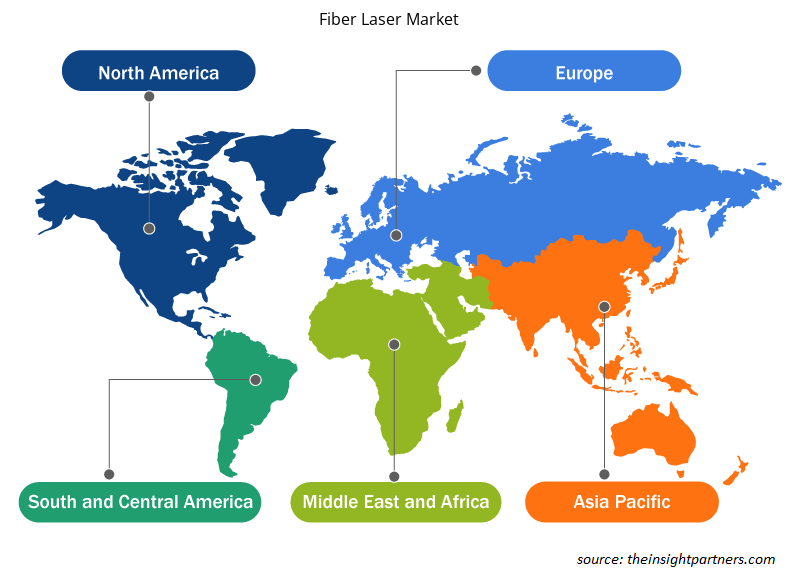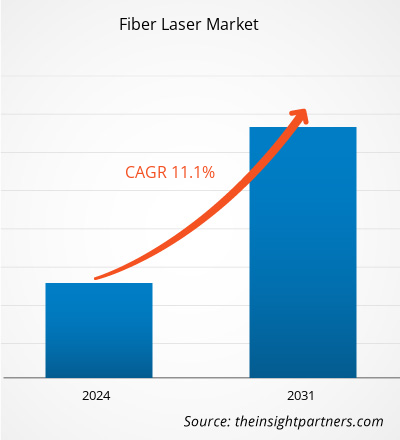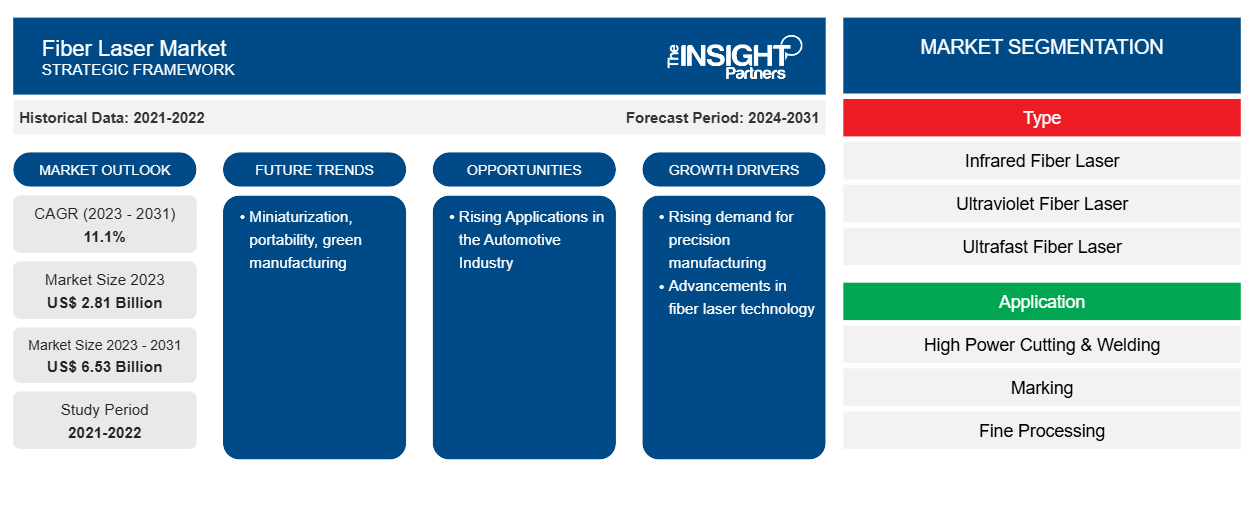Si prevede che la dimensione del mercato dei laser a fibra raggiungerà i 6,53 miliardi di dollari entro il 2031, rispetto ai 2,81 miliardi di dollari del 2023. Si prevede che il mercato registrerà un CAGR dell'11,1% nel periodo 2023-2031. La miniaturizzazione, la portabilità e la produzione ecologica rimarranno probabilmente una tendenza chiave nel mercato.
Analisi di mercato del laser a fibra
Le applicazioni per le macchine per il taglio di materiali ultra-duri si stanno espandendo in numerosi settori, tra cui semiconduttori ed elettronica, estrazione mineraria e difesa. L'integrazione delle tecnologie all'avanguardia, come i laser a fibra, nella macchina per il taglio ultra-duro ha reso possibile tutto ciò. Si prevede che le tecnologie laser a fibra troveranno una preferenza straordinariamente elevata dopo che il loro prezzo scenderà tramite lo sviluppo del prodotto e una maggiore competitività di mercato. Le tecnologie laser a fibra sono riconosciute per essere circa trenta volte più veloci delle macchine a scarica elettrica.
Panoramica del mercato dei laser a fibra
Nel mondo attuale, i laser a fibra sono ampiamente utilizzati. Sono frequentemente utilizzati in contesti industriali per eseguire tagli, marcature, saldature, pulizie, testurizzazioni, forature e molte altre attività, grazie alle diverse lunghezze d'onda che possono produrre. Sono impiegati anche in altri settori, tra cui sanità e telecomunicazioni. Esistono numerose applicazioni per i laser a fibra nel settore manifatturiero. I laser a fibra CW con requisiti di manutenzione bassi o nulli sono ideali per applicazioni specifiche dell'industria pesante in cui efficienza e velocità sono particolarmente cruciali. Ad esempio, i laser CW sono perfetti per il taglio laser, la foratura laser e la saldatura laser. Uno strumento ideale per tagli altamente specializzati in forme complesse è un laser a fibra pulsata. Tali applicazioni stanno guidando la crescita del mercato.
Personalizza questo report in base alle tue esigenze
Riceverai la personalizzazione gratuita di qualsiasi report, comprese parti di questo report, o analisi a livello nazionale, pacchetto dati Excel, oltre a usufruire di grandi offerte e sconti per start-up e università
-
Scopri le principali tendenze di mercato in questo rapporto.Questo campione GRATUITO includerà analisi di dati che spaziano dalle tendenze di mercato alle stime e alle previsioni.
Driver e opportunità del mercato laser a fibra
La crescente domanda di produzione di precisione favorisce il mercato
La microlavorazione di caratteristiche fini è ora una componente cruciale della produzione ad alto volume in una varietà di settori, tra cui elettronica di consumo, dispositivi medici e automotive. Al contrario, i laser a fibra sono emersi come standard di settore per la marcatura laser e l'elaborazione macro. Il panorama della produzione è cambiato a seguito del taglio laser, che offre alle aziende maggiore flessibilità, velocità e precisione. Con il continuo progresso della tecnologia, si prevede che il taglio laser avrà un impatto maggiore sul modo in cui la produzione e l'innovazione saranno eseguite in futuro.micromachining is now a crucial component of
Applicazioni in crescita nel settore automobilistico
In termini di tagli precisi e di alta qualità, l'impiego di laser cutter nell'industria automobilistica è stato generalmente considerato efficace. Una moltitudine di materiali può essere tagliata rapidamente ed efficacemente con i laser cutter. Ciò comporta tempi di produzione migliori e costi inferiori. Inoltre, forniscono più uniformità e precisione rispetto alle tecniche di taglio convenzionali, il che può ridurre la quantità di errori e difetti nel prodotto finito. Poiché i tagli precisi consentono l'uso efficace delle materie prime, l'uso di laser cutter può anche aiutare a ridurre al minimo lo spreco di materiale. Grazie alle loro dimensioni ridotte, i laser cutter in fibra possono essere facilmente integrati negli attuali processi di produzione e occupare meno superficie.
Analisi della segmentazione del rapporto di mercato del laser a fibra
I segmenti chiave che hanno contribuito alla derivazione dell'analisi di mercato del laser a fibra sono tipologia e applicazione.
- In base al tipo, il mercato dei laser a fibra è suddiviso in laser a fibra infrarossa, laser a fibra ultravioletta, laser a fibra ultraveloce e laser a fibra visibile. Il segmento dei laser a fibra infrarossa ha detenuto la quota maggiore nel 2023.ultrafast fiber laser, and visible fiber laser. The infrared fiber laser segment held the largest share in 2023.
- In base all'applicazione, il mercato è suddiviso in taglio e saldatura ad alta potenza, marcatura, lavorazione fine e microlavorazione.
Analisi della quota di mercato del laser a fibra per area geografica
L'ambito geografico del rapporto sul mercato dei laser a fibra è suddiviso principalmente in cinque regioni: Nord America, Asia Pacifico, Europa, Medio Oriente e Africa, Sud e Centro America.
L'Asia Pacific detiene una quota significativa del mercato dei laser a fibra nel 2023. La regione ha un importante polo manifatturiero e un'industria automobilistica consolidata. I laser a fibra trovano importanti applicazioni in questi settori per la produzione di precisione, guidando così la crescita nella regione.
Approfondimenti regionali sul mercato dei laser a fibra
Le tendenze regionali e i fattori che influenzano il mercato dei laser a fibra durante il periodo di previsione sono stati ampiamente spiegati dagli analisti di Insight Partners. Questa sezione discute anche i segmenti e la geografia del mercato dei laser a fibra in Nord America, Europa, Asia Pacifico, Medio Oriente e Africa e America meridionale e centrale.

- Ottieni i dati specifici regionali per il mercato laser a fibra
Ambito del rapporto sul mercato dei laser a fibra
| Attributo del report | Dettagli |
|---|---|
| Dimensioni del mercato nel 2023 | 2,81 miliardi di dollari USA |
| Dimensioni del mercato entro il 2031 | 6,53 miliardi di dollari USA |
| CAGR globale (2023-2031) | 11,1% |
| Dati storici | 2021-2022 |
| Periodo di previsione | 2024-2031 |
| Segmenti coperti |
Per tipo
|
| Regioni e Paesi coperti |
America del Nord
|
| Leader di mercato e profili aziendali chiave |
|
Densità dei player del mercato laser a fibra: comprendere il suo impatto sulle dinamiche aziendali
Il mercato del mercato laser a fibra sta crescendo rapidamente, spinto dalla crescente domanda degli utenti finali dovuta a fattori quali l'evoluzione delle preferenze dei consumatori, i progressi tecnologici e una maggiore consapevolezza dei vantaggi del prodotto. Con l'aumento della domanda, le aziende stanno ampliando le loro offerte, innovando per soddisfare le esigenze dei consumatori e capitalizzando sulle tendenze emergenti, il che alimenta ulteriormente la crescita del mercato.
La densità degli operatori di mercato si riferisce alla distribuzione di aziende o società che operano in un particolare mercato o settore. Indica quanti concorrenti (operatori di mercato) sono presenti in un dato spazio di mercato in relazione alle sue dimensioni o al valore di mercato totale.
Le principali aziende che operano nel mercato dei laser a fibra sono:
- Sistemi in fibra attiva GmbH
- Società di fotonica IPG
- Azienda
- Fotonica convergente
- Coerente, Inc.
- Azienda Jenoptik
Disclaimer : le aziende elencate sopra non sono classificate secondo un ordine particolare.

- Ottieni una panoramica dei principali attori del mercato laser a fibra
Notizie e sviluppi recenti sul mercato dei laser a fibra
Il mercato dei laser a fibra viene valutato raccogliendo dati qualitativi e quantitativi post-ricerca primaria e secondaria, che includono importanti pubblicazioni aziendali, dati associativi e database. Di seguito sono elencati alcuni degli sviluppi nel mercato dei laser a fibra:
- L'azienda high-tech TRUMPF ha acquisito una quota dell'80 percento in Active Fiber Systems GmbH (AFS), un'azienda con sede a Jena, in Germania, specializzata in laser a fibra. AFS sviluppa e produce sistemi laser a impulsi ultracorti e sistemi laser a fibra utilizzati principalmente in ambito scientifico e di ricerca. Oltre alla ricerca di base, i suoi campi di applicazione includono la generazione di luce a lunghezza d'onda estremamente corta con elevata coerenza, imaging biomedico e lavorazione dei materiali. (Fonte: TRUMPF, comunicato stampa, febbraio 2022)
- IPG Photonics Corporation (NASDAQ: IPGP), leader mondiale nella tecnologia laser a fibra, presenterà nuove e innovative soluzioni laser al The Battery Show dal 12 al 14 settembre 2023, a Novi, Michigan, USA. IPG presenterà una nuova sorgente laser Adjustable Mode Beam (AMB) in grado di ottenere un raggio laser monomodale da 3 kW nel nucleo. Una novità assoluta nel settore, questo aumento della potenza monomodale offre miglioramenti senza precedenti in termini di velocità e produttività per la saldatura delle batterie con velocità di saldatura senza spruzzi fino a 2 volte più veloci rispetto a quelle possibili con potenze del nucleo inferiori. (Fonte: IPG Photonics Corporation, comunicato stampa, agosto 2023)
Copertura e risultati del rapporto sul mercato dei laser a fibra
Il rapporto "Dimensioni e previsioni del mercato del laser a fibra (2021-2031)" fornisce un'analisi dettagliata del mercato che copre le seguenti aree:
- Dimensioni e previsioni del mercato dei laser a fibra a livello globale, regionale e nazionale per tutti i principali segmenti di mercato coperti dall'ambito
- Tendenze del mercato dei laser a fibra, nonché dinamiche di mercato come driver, vincoli e opportunità chiave
- Analisi dettagliata delle cinque forze PEST/Porter e SWOT
- Analisi di mercato del laser a fibra che copre le principali tendenze del mercato, il quadro globale e regionale, i principali attori, le normative e i recenti sviluppi del mercato
- Analisi del panorama industriale e della concorrenza che copre la concentrazione del mercato, l'analisi della mappa di calore, i principali attori e gli sviluppi recenti per il mercato dei laser a fibra
- Profili aziendali dettagliati
- Analisi storica (2 anni), anno base, previsione (7 anni) con CAGR
- Analisi PEST e SWOT
- Valore/volume delle dimensioni del mercato - Globale, Regionale, Nazionale
- Industria e panorama competitivo
- Set di dati Excel
Report recenti
Rapporti correlati
Testimonianze
Motivo dell'acquisto
- Processo decisionale informato
- Comprensione delle dinamiche di mercato
- Analisi competitiva
- Analisi dei clienti
- Previsioni di mercato
- Mitigazione del rischio
- Pianificazione strategica
- Giustificazione degli investimenti
- Identificazione dei mercati emergenti
- Miglioramento delle strategie di marketing
- Aumento dell'efficienza operativa
- Allineamento alle tendenze normative























 Ottieni un campione gratuito per - Mercato del laser a fibra
Ottieni un campione gratuito per - Mercato del laser a fibra